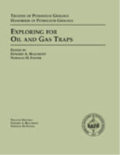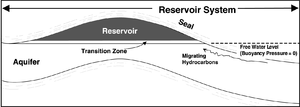Reservoir system
| Exploring for Oil and Gas Traps | |

| |
| Series | Treatise in Petroleum Geology |
|---|---|
| Part | Predicting the occurrence of oil and gas traps |
| Chapter | Predicting reservoir system quality and performance |
| Author | Dan J. Hartmann, Edward A. Beaumont |
| Link | Web page |
| Store | AAPG Store |
The term “reservoir” creates confusion between different disciplines. Explorationists apply the term to mean a porous and permeable rock regardless of the fluid it contains. Reservoir engineers apply the term to mean a rock that contains hydrocarbons and associated fluids. This difference in meanings can cause problems for multidisciplinary teams unless the terminology is clear.
Reservoir system components
In this discussion, a reservoir system is a water–hydrocarbon system contained within the pores of a rock unit. A reservoir system has three main components: a reservoir, an aquifer, and a transition zone (interface) between the two.
- A reservoir is a porous and permeable rock saturated with oil or gas in buoyancy pressure equilibrium with a free water level (zero buoyancy pressure). It has one or more containers and is located below a seal.
- A transition zone is the interval of rock separating the reservoir from the aquifer; it is less than 100% saturated with water.
- An aquifer is a porous and permeable rock 100% saturated with water. It has one or more containers that may or may not be shared with a reservoir.
The diagram in Figure 1 illustrates the major components of a conventional reservoir system.
Waste and transition zones
A waste zone may be found at the top of a reservoir, just below the seal, if there is a decrease in the size of the pore throat radii of the reservoir. It generally produces hydrocarbon and water on a production test.[1]
A transition zone is located at the base of a reservoir and forms as a result of a loss of buoyancy pressure in the hydrocarbon phase. Pore throat diameter and fluid densities determine its thickness. It generally produces hydrocarbon and water on a production test.
Free water level
The free water level is located at the base of a hydrocarbon column and the transition zone. Above this level, the reservoir produces water alone, hydrocarbon and water, or hydrocarbon alone on a production test. Below this level lies the aquifer of a water-drive reservoir system. It produces water only. Zero buoyancy pressure exists at this level or below.
References
- ↑ Schowalter, T. T., 1979, Mechanics of secondary hydrocarbon migration and entrapment: AAPG Bulletin, v. 63, no. 5, p. 723-760.
See also
- Analyzing a reservoir system
- Defining flow units and containers
- Reservoir drive mechanisms
- Predicting reservoir drive mechanism
